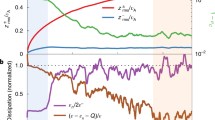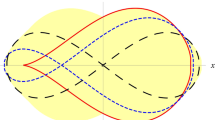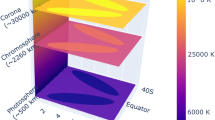Abstract
THE intensity variations of the cosmic radiation during the solar cycle can be well simulated by assuming a heliocentric decelerating potential that is applied to the particles arriving from interstellar space1,2. During the past few years experimental and theoretical understanding of the process of solar modulation has improved greatly. It now seems that a full treatment of the diffusive-convective motions of the particles in the radially expanding solar wind results in an energy loss by the individual particles which can, on average, be treated as analogous to the effects of a potential, except for particles of quite low energies ≤ 100 MeV, where the analogy fails.
This is a preview of subscription content, access via your institution
Access options
Subscribe to this journal
Receive 51 print issues and online access
$199.00 per year
only $3.90 per issue
Buy this article
- Purchase on Springer Link
- Instant access to full article PDF
Prices may be subject to local taxes which are calculated during checkout
Similar content being viewed by others
References
Ehmert, A., Proc. Intern. Union Pure Appl. Phys. Conf., Moscow, 4, 142 (1959).
Freier, P. S., and Waddington, C. J., Space Sci. Rev., 4, 313 (1965).
Lezniak, J. A., and Webber, W. R., J. Geophys. Res., 76, 1605 (1971).
Goldstein, M. L., Fisk, L. A., and Ramaty, R., Phys. Rev. Lett., 25, 832 (1970).
Skilling, J., Astrophys. J., 170, 265 (1971).
Price, P. B., Peterson, D. D., Fleischer, R. L., O'Ceallaigh, C., O'Sullivan, D., and Thompson, A., Acta Phys. Hung., 29, Suppl. 1, 417 (1970).
Freier, P. S., Long, C. E., Cleghorn, T. F., and Waddington, C. J., Proc. Intern. Union Pure Appl. Phys. Conf., Hobart, 1, 252 (1971).
Cartwright, B. G., Munoz Garcia, M., and Simpson, J. A., Proc. Intern. Union Pure Appl. Phys. Conf., Hobart, 1, 215 (1971).
Author information
Authors and Affiliations
Rights and permissions
About this article
Cite this article
WADDINGTON, C. Physical Sciences: Solar Modulation and the Chemical Composition of the Cosmic Radiation. Nature 236, 391–392 (1972). https://doi.org/10.1038/236391a0
Received:
Revised:
Issue Date:
DOI: https://doi.org/10.1038/236391a0
Comments
By submitting a comment you agree to abide by our Terms and Community Guidelines. If you find something abusive or that does not comply with our terms or guidelines please flag it as inappropriate.



